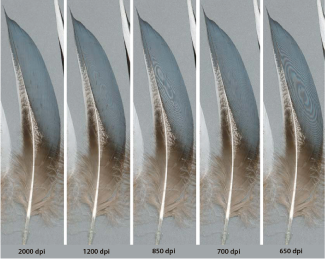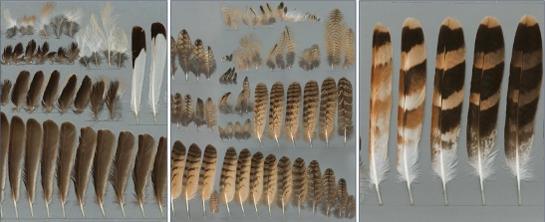







Sample images
 Feathers can be difficult objects to scan and print. Their structure, which consists of barbs at regular intervals, can create interferences
with the dpi intervals of the resolution chosen for a scan. These interferences can result in Moiré patterns and so-called Newton Rings.
It is the same effect that can be observed when two fly screens are held on top of each other with slightly different angles. Here also,
Newton Rings are created by the interferences of the structure of the two fly screens.
Feathers can be difficult objects to scan and print. Their structure, which consists of barbs at regular intervals, can create interferences
with the dpi intervals of the resolution chosen for a scan. These interferences can result in Moiré patterns and so-called Newton Rings.
It is the same effect that can be observed when two fly screens are held on top of each other with slightly different angles. Here also,
Newton Rings are created by the interferences of the structure of the two fly screens.
The example above shows the same feather scanned with five different resolutions, 2000 dpi, 1200 dpi, 850 dpi, 700 dpi and 650 dpi. Only the feather on the far left, scanned at a high resolution of 2000 dpi, is free from Newton Rings. At all other resolutions, Newton Rings are created on the scans.
Once a feather has been scanned at a resolution free from such artifacts, the next difficulty lies in choosing the right screening resolution and angles for cyan, magenta, yellow and black for printing. The angles of conventional screening used in offset printing can easily create new or additional interferences with the feathers. A printing technique that avoids such problems is frequency modulated screening, which uses extremely small dots that are not arranged in regular screening patterns but distributed in a random pattern instead. This printing technique was especially developed to print the texture of clothes by avoiding the above-mentioned interference patterns. It is equally well suited to print the texture of feathers. Feather scans printed with frequency modulated screening show even the most subtle details in the feathers.


 English
English Deutsch
Deutsch Français
Français Italiano
Italiano 日本語
日本語 Español
Español Português
Português Russian
Russian Chinese (Simp.)
Chinese (Simp.) Czech
Czech Polish (Store only)
Polish (Store only)